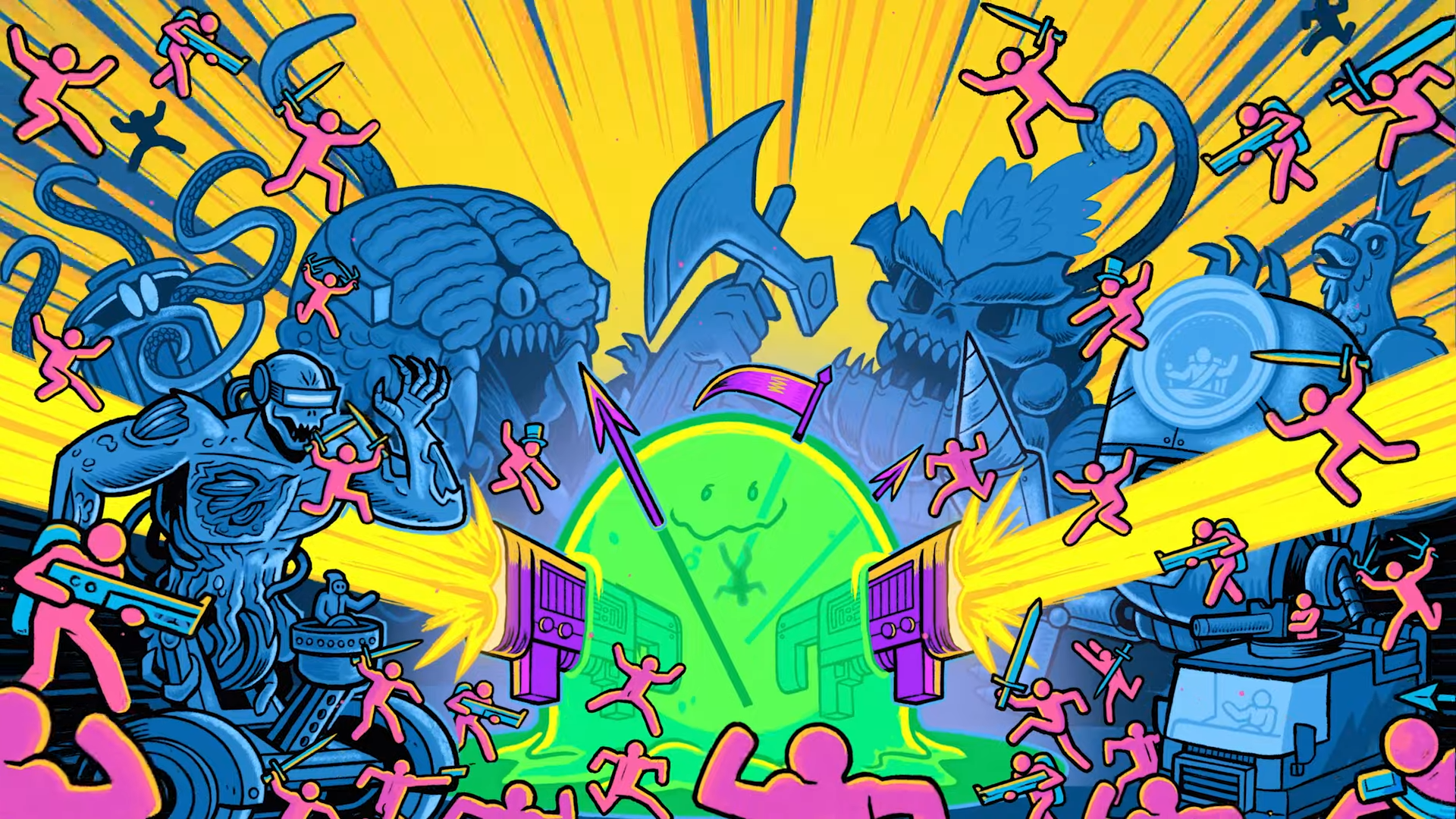Slime 3K: Rise Against Despot is basically a horror game. Not that you’d notice: It tries to mask its horror as best it can, hiding behind a silly, giddy façade, delighting in quirky abilities, quippy one-liners and a general sense of irreverence. You mow down an unending army of puny human enemies—some with shields and swords, others dressed like Sailor Moon—with boomerang bananas and olive guns, leaving behind an ocean of skeletons in your wake, and the game celebrates with smiles and applause.
Slime 3K is cute. It’s fun. But look deeper, and the horror at its core is tied implicitly to the charming destruction that is intimately familiar to anyone who’s dabbled in the new genre of Vampire Survivors-likes before.
Transforming leveling and stat growth into a physical mechanic, games in this style are all about unbridled evolution, what begins as weak and small rapidly growing into something unrecognizable, deadly and strong. This is even more literal in Slime3K: you’re a smiling ball of slime whose body physically changes with each power-up. Where once was nothing is now an eye, or a cyst, or floating gore, or a giant needle sticking out. It is a game about twisting and deforming and breaking yourself in the name of power and control.
Why am I hardly doing any damage? What do you mean I can’t pick that up? Hold on, I’m already dead?
There are differences to the Vampire Survivors standard, though, which complicate this idea. You’re big and slow, a massive, crawling target that can barely dodge a thing. Coupled with relatively small, constrained levels, play sessions can easily feel claustrophobic—less a power-trip of attaining godhood and more a desperate battle of attrition and evolution for pure survival. And with an absolute metric ton of health pick-ups and temporary speed boosts littering the field, it is very common to end up lost in a sea of baddies playing a game of health bar management, planning and executing on routes that run through the infinite horde to keep that green bar just above zero.
Leveling itself is also more restrained. With a limited inventory and the need to collect and combine three of the same ability in order to strengthen it, you never have enough space for what you want and are constantly forced to make sacrifices for what you need.
In the beginning this can be maddening. Why am I hardly doing any damage? What do you mean I can’t pick that up? Hold on, I’m already dead? But once you get a handle on these constraints, a satisfying tension replaces the frustration: Always outnumbered and outpowered, wins don’t come because you got lucky, but because you understood and manipulated the limited resources at your disposal, and they feel more earned because of it. In Slime 3K, evolution isn’t liberating, it is something to struggle with. This is not a game about freedom.
(Image credit: Team17)
It’s also not a game about in-the-moment experimentation: There are no hidden item combinations or secrets in the levels or even weapons which change drastically when fully powered. Instead, Slime 3K uses a deckbuilding system, letting you pick and choose what weapons and items will show up in the level. This fits well with the more methodical pacing, and has that deckbuilding allure of tweaking your deck after each loss until it has been shaped into a perfect and pure collection of synergized abilities.
But it also kills spontaneity. Every session becomes predictable and planned. Mass slaughter as a bouncy slime ball is just day-to-day work in this dystopian world of rundown laboratories and all-seeing surveillance.
You’re not just a puddle of slime because puddles of slime are cute—it’s the perfect vessel for letting your character morph until it is entirely unrecognizable. Your youness hardly matters at all because this is a game where, by design, so much seems to happen and nothing really does. You do the same things over and over—think the same thoughts, execute the same plan: move around, collect health, and watch with empty satisfaction as numbers fill the screen.
Playing Slime 3K feels good. Time flies when I’m with it, and when I’m not, I’m often thinking about it. But what is really happening? Despite its best efforts to differentiate itself, Slime3K’s biggest strengths—its tension and claustrophobia—quickly fade into the same endless repetition inherent to the genre. There’s no surprise, no wrenches thrown (metaphorical wrenches; you can throw plenty of literal wrenches even without arms) to keep you on your toes and fully engaged. When the game turns on, my mind goes blank, emotions stalled at a warm buzz as I move my slime in the exact same way, watching my health bar go up and down with the only faintest sense of accomplishment.
When playing, I become the slime, smiling and happy and totally empty, allowing myself to be consumed. I level and grow; the brain gently hums. Nothing changes.
That’s the source of the horror: Throughout your life, you will grow and evolve—you will age, gain experience and knowledge, meet new people, make new relationships—and yet at the end of the line, it all ends up the same. In the end, no matter what you do, you’re still gonna end up a big ball of slime.











